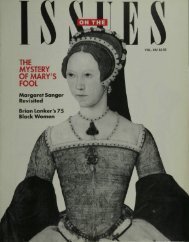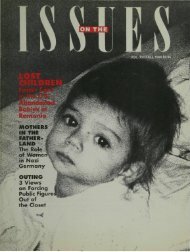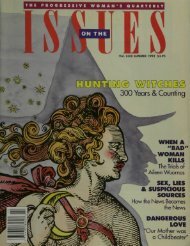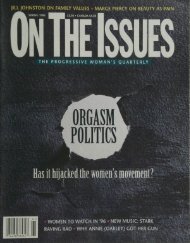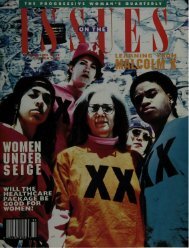I Am Beautiful: A Celebration of Women in Their Own Words
I Am Beautiful: A Celebration of Women in Their Own Words
I Am Beautiful: A Celebration of Women in Their Own Words
Create successful ePaper yourself
Turn your PDF publications into a flip-book with our unique Google optimized e-Paper software.
BY RUBY R O H R L I C H1I OW COULD YOU RETURN TO LIVE INa country that persecuted you, that took away your citizenship,your pr<strong>of</strong>ession, and forced you to live undergroundto survive?" Rita Levi-Montalc<strong>in</strong>i, w<strong>in</strong>ner <strong>of</strong> the 1986Nobel Prize <strong>in</strong> Science, never answered my question. Instead,smil<strong>in</strong>g a little, she set down her water<strong>in</strong>g can amidthe dozens <strong>of</strong> coral and crimson plants and went to thebook shelves <strong>in</strong> the apartment she shares with her tw<strong>in</strong> sister,Paola. When she returned to the room, Levi-Montalc<strong>in</strong>igave me an armful <strong>of</strong> family papers, books, and descriptions<strong>of</strong> her- Nobel-w<strong>in</strong>n<strong>in</strong>g discovery <strong>of</strong> Nerve GrowthFactor, a natural chemical that helps nerve cells to navigateand survive and may someday be used to regenerate damagedor severed nerves.Born <strong>in</strong> 1909, Rita Levi-Montalc<strong>in</strong>i will soon be 88 yearsold. Her slim carriage is erect, her hands don't tremble, shedoesn't wear glasses. Her thick, gray hair is smartly and simplystyled, and so are her clothes. Her hyphenated name, andthe elegant gold jewelry she wore, once led an <strong>Am</strong>erican psychologistwho encountered Rita at scientific meet<strong>in</strong>gs to assumeshe was supported by a wealthy Italian husband.Noth<strong>in</strong>g could be further from the facts <strong>of</strong> her life.An anxious child, Rita Levi-Montalc<strong>in</strong>i grew up utterlylack<strong>in</strong>g <strong>in</strong> self-confidence, afraid <strong>of</strong> her father, Adamo Levi.A bus<strong>in</strong>essman with an exuberant love <strong>of</strong> opera, Adamowas also a controll<strong>in</strong>g patriarch; his wife, Adele Montalc<strong>in</strong>i,n<strong>in</strong>e years his junior, accepted his authority and toleratedhis explosive temper. Paola was not <strong>in</strong>timidated by theseverity and pierc<strong>in</strong>g quality <strong>of</strong> Adamo's gaze, the silentflar<strong>in</strong>g <strong>of</strong> the nostrils preced<strong>in</strong>g his brief but violent outbursts<strong>of</strong> anger, the imperious voice. Rita trembled withfear when she saw such behavior and, extend<strong>in</strong>g this fearto all adults, fled from them. Her father's stories about theprecarious situation <strong>of</strong> Jews under the Italian Inquisitionand dur<strong>in</strong>g the pogroms <strong>in</strong> Eastern Europe gave her nightmares<strong>in</strong>to adulthood.Undoubtedly it was also Adamo's temperament that impelledhim to make all the decisions <strong>in</strong> the household, rightdown to the k<strong>in</strong>ds <strong>of</strong> hats worn by the tw<strong>in</strong> girls. When itcame time for higher education, it took two years for Ritato persuade her father to allow her to enter medical school.Accord<strong>in</strong>g to Adamo, two <strong>of</strong> his six sisters, both <strong>of</strong> whomhad doctoral degrees, had found it very difficult to reconciletheir studies with their conjugal and maternal roles.Adamo objected that medic<strong>in</strong>e "was a long and difficultcourse <strong>of</strong> study, unsuitable for a woman." The young Ritahad already decided to forego marriage, however, and shehad no <strong>in</strong>terest at all <strong>in</strong> babies. In her autobiography, InPraise <strong>of</strong> Imperfection, she wrote that "the subord<strong>in</strong>ate roleplayed by the female <strong>in</strong> a society run entirely by men madethe status <strong>of</strong> a wife less than attractive."F<strong>in</strong>ally her father yielded. Rita and her cous<strong>in</strong>, Eugenia,Anthropologist RUBY ROHRLICH PH.D. has authored numerouspapers on women. She is currently work<strong>in</strong>g on a book,Scientists as Survivors: From Ashes <strong>in</strong>to the Light.S p r i n g 1 9 9 7 • O N T H E I S S U E Sspent a year prepar<strong>in</strong>g for entrance exams: with the help <strong>of</strong>tutors, they learned Lat<strong>in</strong>, Greek and mathematics. The twoyoung women studied philosophy, literature and historyon their own. <strong>Their</strong> concentration was rewarded when Ritascored highest on the list <strong>of</strong> candidates on the entranceexams. In 1930, both she and Eugenia enrolled <strong>in</strong> Tur<strong>in</strong> UniversityMedical School on the banks <strong>of</strong> the River Po.Rita was one <strong>of</strong> seven women <strong>in</strong> a class <strong>of</strong> 300 students;she made few friends at the university. A classmate oncedescribed her "as a k<strong>in</strong>d <strong>of</strong> squid, ready to squirt <strong>in</strong>k atanybody who came near." She did, however, attract a mentor,Giuseppe Levi (no relation). Later, she would describehim as "celebrated <strong>in</strong> Tur<strong>in</strong> University as a scientist, for theanti-fascism he pr<strong>of</strong>essed with supreme disda<strong>in</strong> for themost elementary rules <strong>of</strong> caution, and for his terrible butshort-lived fits <strong>of</strong> rage."Rita graduated at the head <strong>of</strong> her class <strong>in</strong> 1936, and wasrewarded with a trip to a scientific conference <strong>in</strong> Sweden.She decided to specialize <strong>in</strong> neurology and psychiatry, andwas given a job as assistant lecturer <strong>in</strong> the anatomy department.But history <strong>in</strong>tervened.Underground ResearchIn 1936 Mussol<strong>in</strong>i's ties with Hitler became closer andthe Italian Fascists began to vilify the Jews. When theanti-Jewish laws were passed <strong>in</strong> 1938, Rita was compelledto leave the university and was barred from do<strong>in</strong>glaboratory research and practic<strong>in</strong>g medic<strong>in</strong>e. Rita hadnever firmly identified herself as Jewish; her father had notifiedhis four children, before they could even read andwrite, that they were freeth<strong>in</strong>kers and could choose orrefuse a religion when they reached the age <strong>of</strong> 21. As theItalian newspapers cont<strong>in</strong>ued their vicious attacks on theJews, Rita at first experienced a k<strong>in</strong>d <strong>of</strong> shock. That shockeventually gave way to a sense <strong>of</strong> liberation from "thenightmare <strong>of</strong> an anti-Semitism, all the more menac<strong>in</strong>g forbe<strong>in</strong>g <strong>in</strong>visible and yet ever present," that had tormentedher s<strong>in</strong>ce early childhood."For the first time I felt pride <strong>in</strong> be<strong>in</strong>g Jewish and not Israelite,as we had been called <strong>in</strong> the liberal climate <strong>of</strong> myearly years," she wrote, "and though still pr<strong>of</strong>oundly secular,I felt a bond with those who were, like me, the victims<strong>of</strong> the lurid campaign unleashed by the Fascist press."In 1940, one <strong>of</strong> her classmates, Rodolfo <strong>Am</strong>primo, proddedher <strong>in</strong>to cont<strong>in</strong>u<strong>in</strong>g her research. With the help <strong>of</strong> herbrother G<strong>in</strong>o, Rita built a laboratory <strong>in</strong> her bedroom. Shecont<strong>in</strong>ued her early research on the nervous system <strong>of</strong> chickembryos. The first experiments turned out well, allow<strong>in</strong>gRita to observe the development <strong>of</strong> the nervous system.Her mentor, Giuseppe Levi, who had been dismissedfrom the University along with all the other Jewish pr<strong>of</strong>essors,became Rita's first assistant, and his students crowded<strong>in</strong>to her bedroom to work and exam<strong>in</strong>e her experiment.In this sett<strong>in</strong>g, Rita replicated an experiment by ViktorHamburger <strong>of</strong> Wash<strong>in</strong>gton University, which she had read<strong>of</strong> <strong>in</strong> a scientific journal. In the w<strong>in</strong>ter <strong>of</strong> 1942, Rita wrote41





